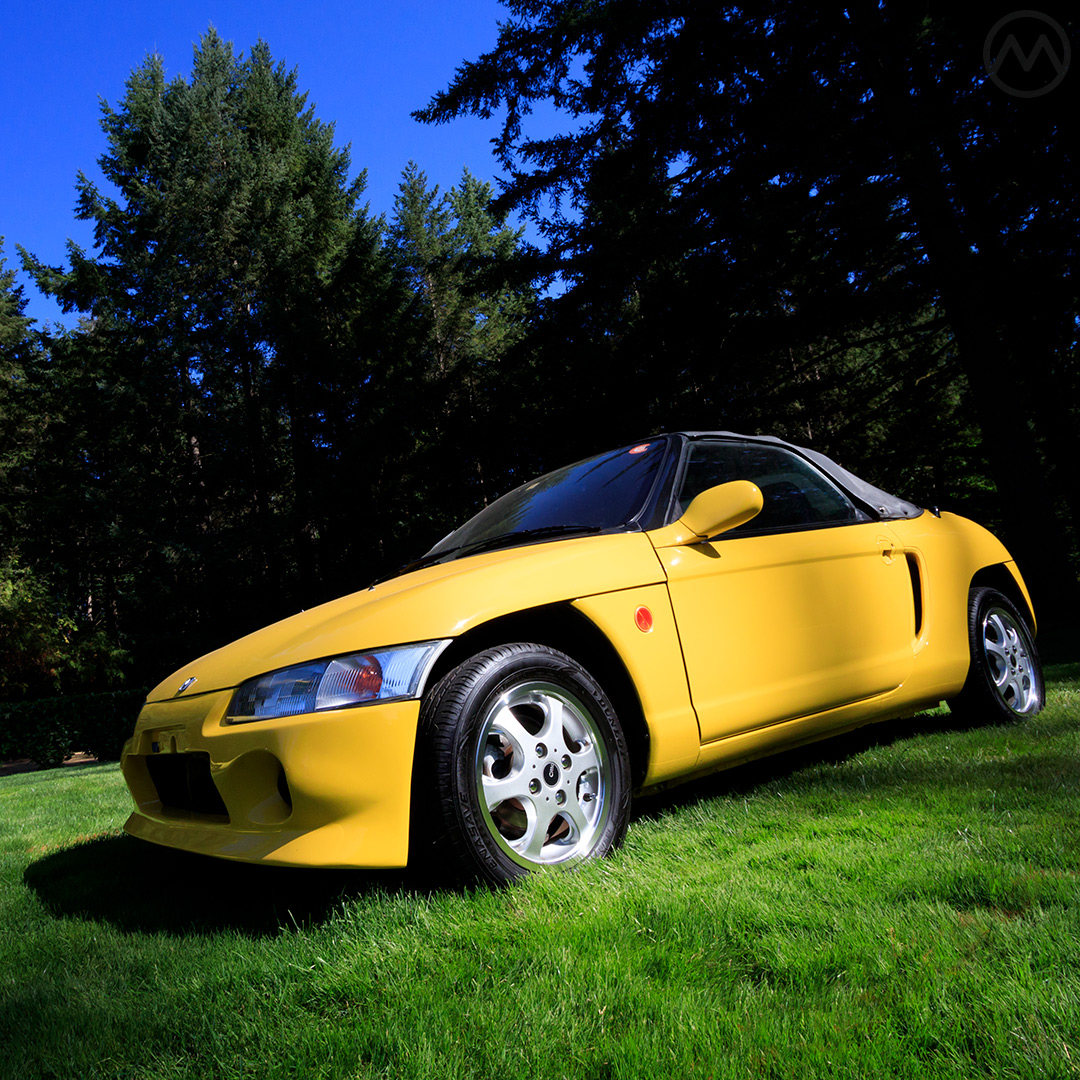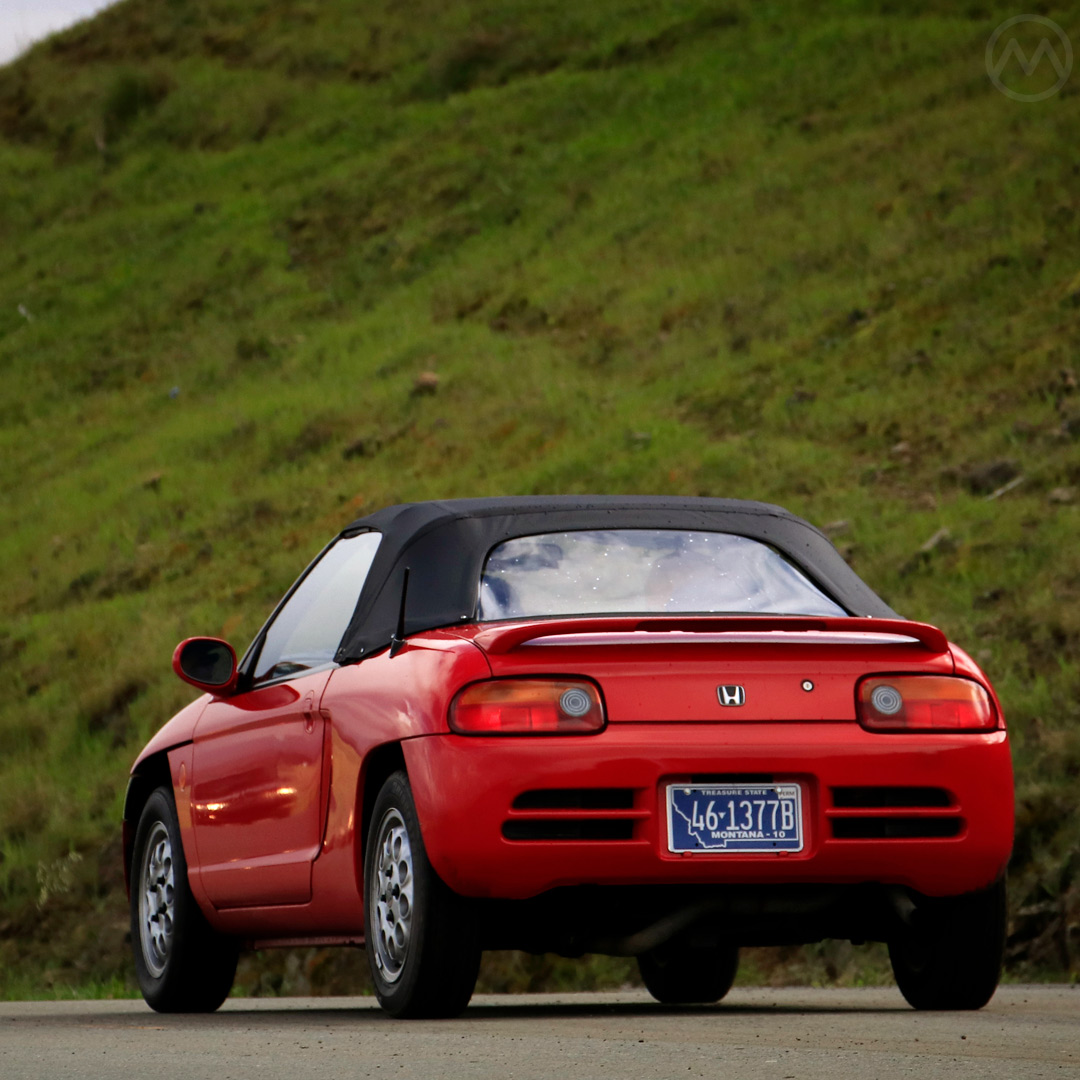By itself it doesn’t look so small – but when it’s parked next to something like that towering Vanagon, you realize how tiny the Honda Beat really is. Taken with a wide angle lens (10mm), this one looks huge – but the VW is about 10 feet behind it and still looms large.
The Beat’s wheelbase is just under one inch longer than an NA Miata, but its overhangs are almost nonexistent. It measures just 10.8’ (3.3M) long and four and a half feet (1.4M) wide. This triumph of packaging was Honda’s contribution to a set of sporty Kei cars that arrived at the tail end of the boom times in 1980s Japan.
The Kei Sports Cars
Most of those sportsters were souped up versions of regular Kies like the Suzuki Alto Works and Mitsubishi Dangan ZZ. At the dawn of the 1990s a set of de facto Kei sports cars arrived – most notably Suzuki’s Cappuccino and Mazda’s AutoZam AZ-1. Although these two were publicly shown first, the Beat was the first of this trio to go on sale.
Despite being a mid-engined, two-seat roadster, the Beat wasn’t necessarily meant to be a proper sports car like the other two, but instead a fun lifestyle car for people on Kei budgets.

It was the last car approved by Soichiro Honda (then 84) himself, and though it was only quietly mentioned at that time, the exterior design came from Pininfarina. Indeed, Pininfarina’s look was almost “off the rack” for Honda.
Under the hood, buried behind the passengers, was a 660-cc triple with Honda’s MTREC system, an individual throttle body for each cylinder. This is not to be confused with VTEC (Variable Valve Timing & Lift Electronic Control), Honda’s later valve timing system. A reasonably direct five-speed delivered the power and kept things on the boil.
The free-revving little motor produced 63 hp with no forced induction. Turbos were common on Keis at that time, but Honda had largely eschewed Turbos after the Mugen-influenced City Turbo of the early eighties.
The lack of overhangs and taut, communicative suspension made it a fun car to drive, if not out-and-out fast. The long-ish wheelbase made it comfy inside in a way the other two were not. From the driver’s seat, the car was again deceptively sized. The Honda Beat feels much bigger than it actually is, though it never feels “big.”
The Czech Connection
Form followed function on the Beat and the exterior came from Pininfarina. The two companies had first worked together in 1982 when Honda commissioned a concept car called the Honda HP-X, which was publicly shown in 1984. This was the start, arguably, of the NSX project although the production NSX was not designed by Pininfarina.
The Beat was the first mass-production Japanese car styled by the famous house. The design was often credited to Pietro Camardella, whose credits already included the Ferrari Mythos and work on the F40 by that time. However, Pininfarina’s Enrico Fumia later revealed that the Beat was actually subcontracted out.
In fact, the design was mostly created by Czech designer Pavel Hušek, but the style house kept it a secret until the mid-2010s.

Hušek had his own independent studio in Ingolstadt at the time. After departing Czechoslovakia for less restrictive pastures, he settled in Germany. A former staffer at BMW, Ford, and Audi, he had worked with Claus Luthe and Patrick le Quément, among many others.
Hušek had talent, a great deal of experience, and availability. He did more than a few sketches for Pininfarina but was also involved tangentially with other design operations. In 1993, he returned to what was by then the Czech Republic.
The Beat debuted in the spring of 1991 to loads of positive headlines from the global press – not just from Japan. That included in the U.S., where it would not pass crash tests and therefore was never sold new.
The Long Tail of the Honda Beat
Like the other sporty Keis, sales were good for the first 18 months of production but then fell off severely during Japan’s long 1990s recession. fuly two-thirds of Beats were built in the first year, but the car continued in production until 1996.
Several special editions were also released, although they didn’t differ too much from the regular Beat package, and all Beats were sold through the Honda Primo network, one of the many byzantine distribution channels in Japan.

Like some other Keis never truly intended for international consumption, there was a considerable appetite for the Honda Beat in other markets. Suzuki went through the trouble of making the Cappuccino available in Europe to meet such demand, but the Beat JDM-only. Private importers soon began shipping them to the U.K., but it was not as popular there as the sportier Cappuccino or the cuter Nissan Figaro.
Honda worked again with Pininfarina in 1995, with the style house producing the Argento Vivo roadster. There was talk of that car being produced by Pininfarina but that did not happen. Instead, as with the HP-X, the concept led to an in-house design: the S2000.

